Some hedges stand in as privacy screens, some allow us to section off “rooms,” and others purely for aesthetics, but all are limited to the space we have, so what hedges are best for short spaces?
The best plants for a small hedge are:
- Euonymus japonicus “Microphyllus Aureovariegatus.”
- Euonymus fortunei “Gold Splash.”
- Buxus sempervirens “Suffruticosa.”
- Littleleaf Boxwood, or Buxus microphylla.
- Burkwood Daphne, or Daphne X Burkwoodii.
- English Yew, or Taxus baccata.
- Dwarf Fothergilla, or Fothergilla gardenii.
- Bearberry Cotoneaster, or Cotoneaster dammeri.
- Daisy Bush, or Olearia X Scilloniensis.
- Bush Honeysuckle, or Diervilla lonicera.
- Japanese Spirea, or Spiraea japonica.
This article will cover 11 of the best plants for a small hedge in detail, and provide advice on how to pick the best one for you. I’ll also cover plant “zoning” and how to find plants that will thrive in your specific climate.
Right below the 11 best plants is a map where you can check in what Plant Hardiness Zone you’re located to pick the best plant for your climate.
1. Euonymus japonicus “Microphyllus Aureovariegatus”
One of several Japanese Spindle cultivars, this particular shrub grows to about three tall and is a pretty low-maintenance and tolerant plant.
This hedge will thrive in full or partial sun, and it grows well in average, run-of-the-mill soil as long as it is well-drained, which means you don’t have to spend a whole lot of time treating your soil before you plant your hedge.
Best suited for Zones 6-9 (I’ll cover plant zoning further in the article), this plant will not do well in colder climates.
Also, if you are in Zones 6-9 you will need to keep the hedges trimmed and make sure of the exact cultivar you have because some Japanese Spindle cultivars grow much taller, meaning you’d have to trim them yearly if you purchased one outside of the low hedges group.
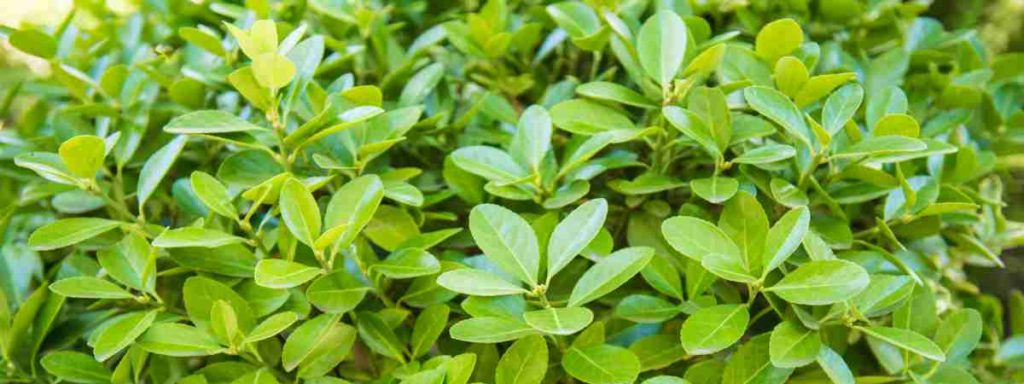
2. Euonymus fortunei “Gold Splash”
A wintercreeper cultivar, Gold Splash is on the shorter side, usually topping out at 18 to 24 inches (45.72 to 60.96 cm). It’s an evergreen shrub, so you’ll have color in your garden even in the winter, but it bears mentioning that Gold Splash is considered an invasive species in some areas.
Gold Splash is versatile, dealing well with anything—full sun to full shade. It doesn’t require a great deal of water, and like Japanese Spindle, it does well in most soil types, provided it’s in a well-drained spot. Ideal zones for it are 5-8.

3. Buxus sempervirens ‘Suffruticosa’
Often called Edging Boxwood, this hedge can potentially be one of the taller boxwoods—up to four feet tall (1.21 m)—though it will still be happy if you keep it even as short as six inches (15.24 cm) high.
It needs some sun, so a full-shade planting would not work well. Zones 5-9 are best for this one.
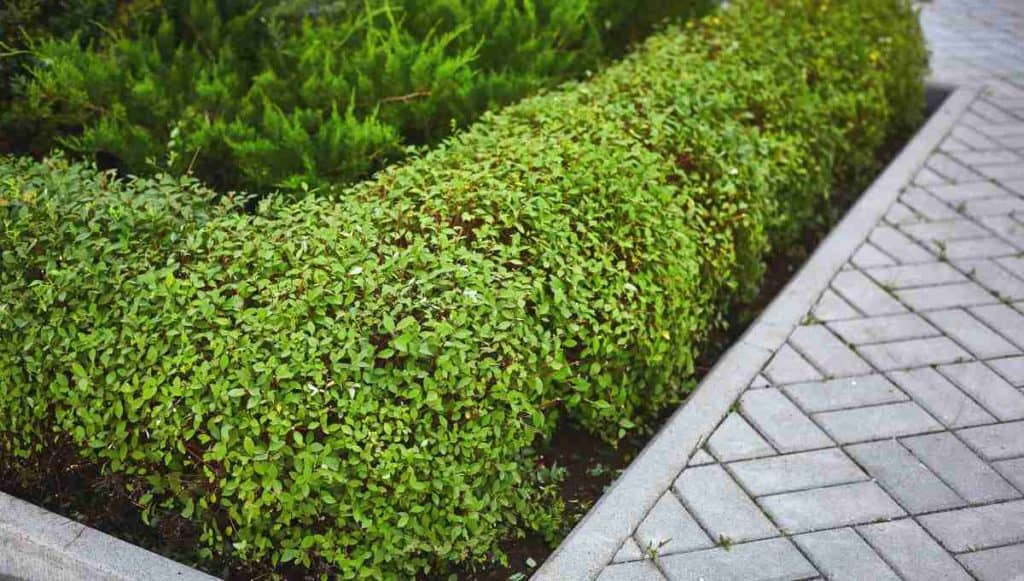
4. Littleleaf Boxwood, or Buxus microphylla
Very popular in the eastern United States, Littleleaf Boxwood gets a lot of use in English gardens. Its leaves are somewhat glossy, though they often turn orange in late winter, making many gardeners fear the plant is dying. However, this color change is normal.
Littleleaf Boxwood grows to about four feet (1.21 m) tall and does best in partial sun. Although this hedge grows best in zones 6-9, there are some cultivars available that are bred explicitly for colder areas.
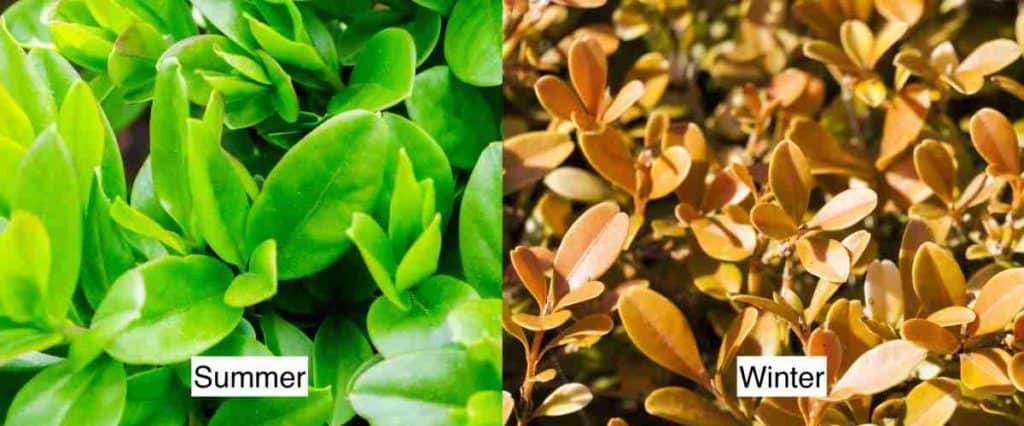
5. Burkwood Daphne, or Daphne X Burkwoodii
The Burkwood Daphne is a bit more finicky when it comes to the soil it wants to live in. However if you plant it in the alkaline soil it prefers, this hedge can quickly grow to three feet (0.91 m) tall, sometimes up to four feet (1.21 m) if you don’t keep it trimmed.
Burkwood Daphne will grow in zone 4 and warmer areas.
It is a semi-evergreen plant, and the blue color spectrum in its leaves makes it very pretty. Its flowers bloom around mid-spring and have a pinkish hue. The hedge has many cultivars and the most popular one, the “Carol Mackie,” has a cream-colored edge to its leaves.
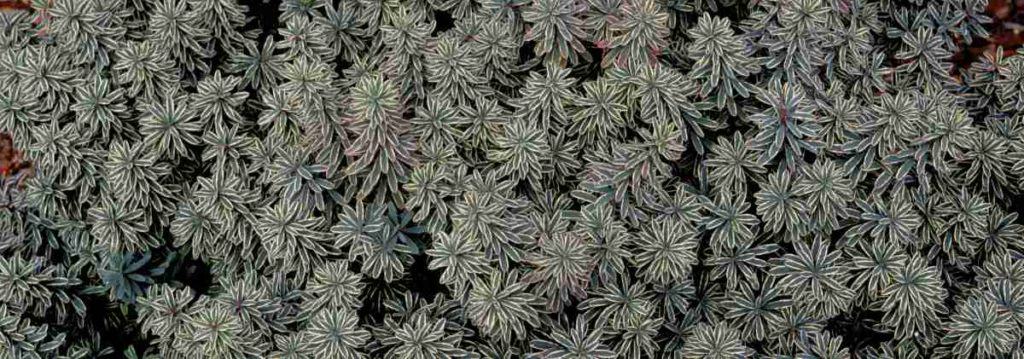
6. English Yew, or Taxus baccata
T. baccata is often overlooked as a hedge plant in the United States, which is unfortunate because it grows pretty densely and has leaves of lovely dark green.
Three feet (0.91 m) is about as short as you want to keep these. The good news there is that English Yew is relatively slow-growing, so you won’t need to be pruning all the time.
Appropriate for zones 4 through 9, this hedge needs some sun, and full sun is okay, too. As long as you don’t plant it in a full-shade location, it should thrive well, provided the soil is well-drained because English Yew is especially susceptible to root rot.
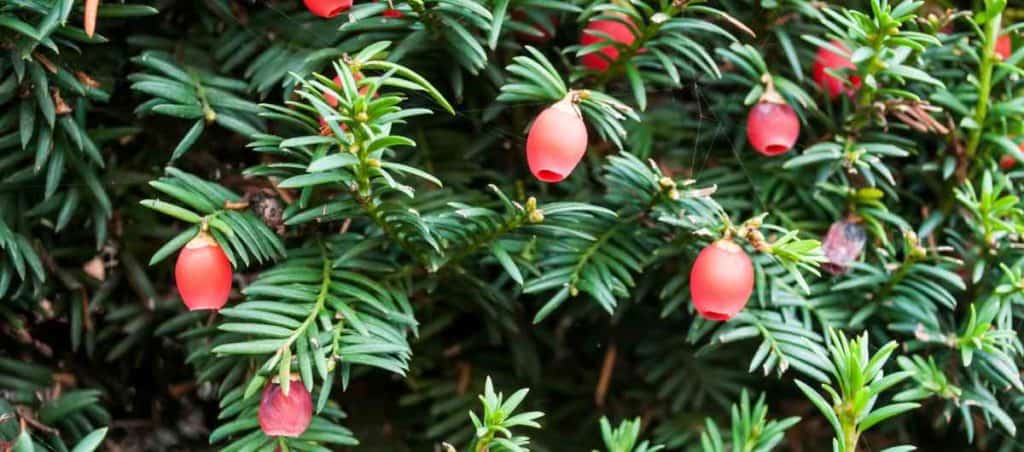
7. Dwarf Fothergilla, or Fothergilla gardenii
This option is best for places where you need a hedge of no more than three inches (7.62 cm) tall, though two feet (0.60 m) is probably a better height to plan for when you’re choosing this one for your landscape.
F. gardenia lends a lot of color to your landscaping, as its leaves are several shades of green in the spring and summer, but when leaves begin to change in the Fall, this hedge joins in and can change to red, yellow, and orange.
Its white flowers are small, although the “Blue Mist” cultivar has blue ones. Dwarf Fothergilla is happiest in zones 5 through 9.

8. Bearberry Cotoneaster, or Cotoneaster dammeri
Because Bearberry doesn’t grow more than a foot (30.48 cm) tall and can grow up to six inches (15.24 cm) in diameter, it is often used as a ground cover instead of a shrub. But it can be trimmed to shape and makes a very nice shrub.
It will spread if you let it, but you can train it, and it will form an admirable thicket for you.
Bearberry wants dry-ish soil, which means it’s drought-resistant, although it will want more water than usual when it’s flowering and fruiting (white flowers, reddish berries). It also prefers loamy soil but will not fail in less-than-ideal soil conditions, provided it’s relatively dry.
In the fall, you may see purple leaves along with reds. Bearberry is easy to grow, and it provides a bonus of helping with soil retention and erosion control. This shrub is best in zones 5-7. It will grow in zone 8 but probably won’t become a wildly successful plant there.
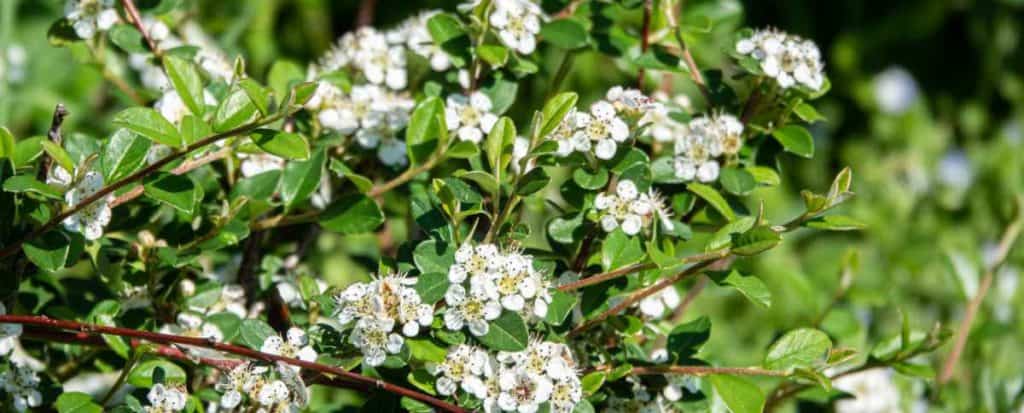
9. Daisy Bush, or Olearia X Scilloniensis
This plant might be hedging our bets a little (see what I did there?) as it’s better suited to grow as a rounded shrub, but hedges with it are possible. It makes an appearance on this list because it’s exceptionally hardy.
It is a full-sun plant, drought-resistant, and almost impervious to disease. It is also unbothered by salty air, which is why it’s a popular hedge in coastal areas.
Daisy bush has white flowers that look, unsurprisingly, like daisies and does well at four feet (1.21 m) tall, though it can grow up to six feet (1.82 m), which would put it out of the “low hedge” category.
Still. It likes well-drained soil, but it’s not the kind of plant that will balk at moist soil, provided there’s drainage. Zones 8-10 are the best places for this one.
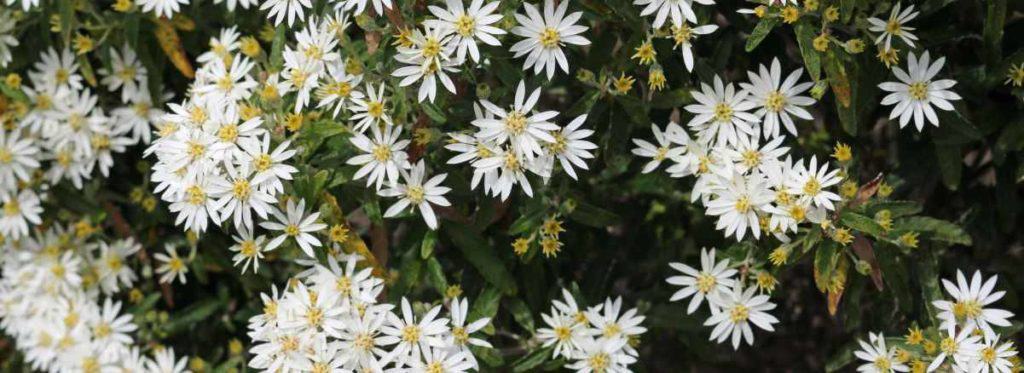
10. Bush Honeysuckle, or Diervilla lonicera
With bronzy-green leaves, Bush Honeysuckle makes a lovely hedge that will turn orange in the fall. It’s a hardy plant that can thrive as far north as Zone 3 and grow up to three feet (0.91 m) tall.
Despite its name, D. lonicera isn’t actually a honeysuckle plant, which is good news since honeysuckle is considered an invasive species in a few parts of the country. It does well in the shade, as indicated by the darkness of the green in its leaves.
Bush Honeysuckle will form thickets, so it’s a fine choice for hedges and provides a bonus of attracting butterflies and hummingbirds with its honeysuckle-ish flowers.
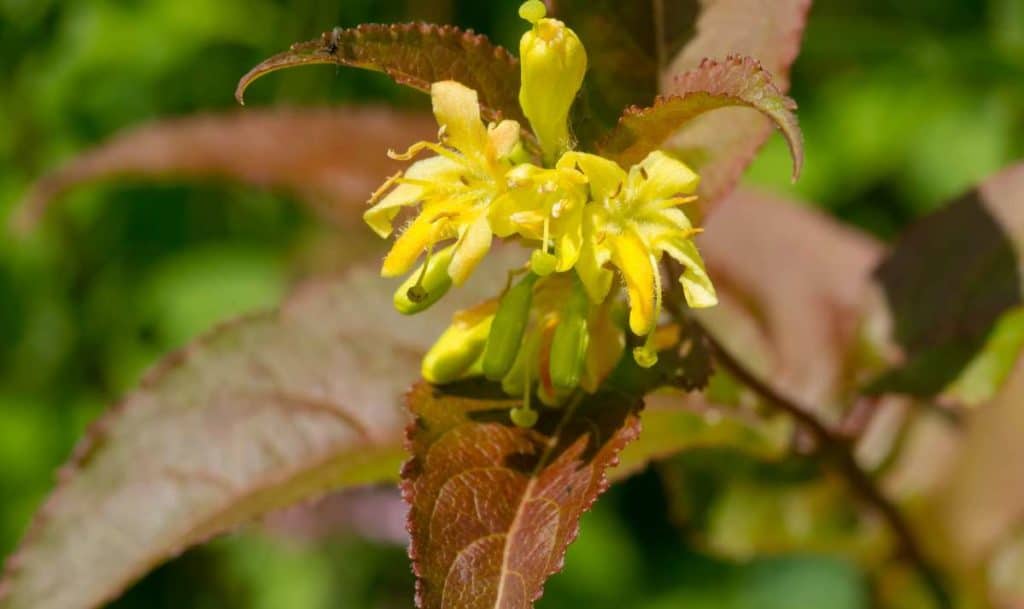
11. Japanese Spirea, or Spiraea japonica
Give this one full sun, average water, and good drainage of its soil, and you can pretty much let it maintain itself. Spirea is hardy, easy-to-grow, reaches about four feet (1.21 m) in height, and offers various cultivars.
Appropriate for zones 3 to 9, S. japonica flowers are pink throughout the summer and it is relatively drought-resistant.
The primary purpose of the different cultivars relates to those summer flowers. “Little Princess” flowers in a light pink, “Shibori” (sometimes called “Shirbana”) offers multi-colored flowers, and “Magic Carpet” has orange-ish leaves in the cooler months and flowers dark pink. So there’s something for everyone.
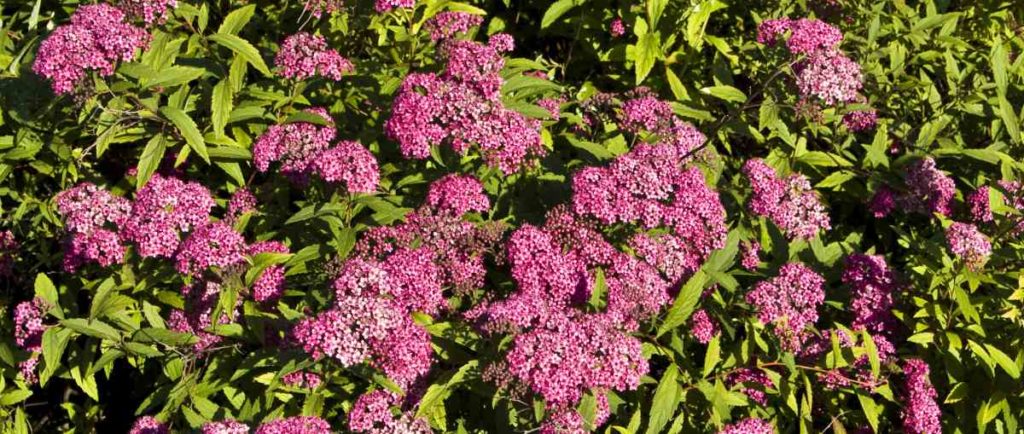
Choosing the Right Plant for Your Location
Above all, we must always consider the USDA Plant Hardiness Zones, as your location on this map will significantly impact the success or failure of your hedges and your garden in general.
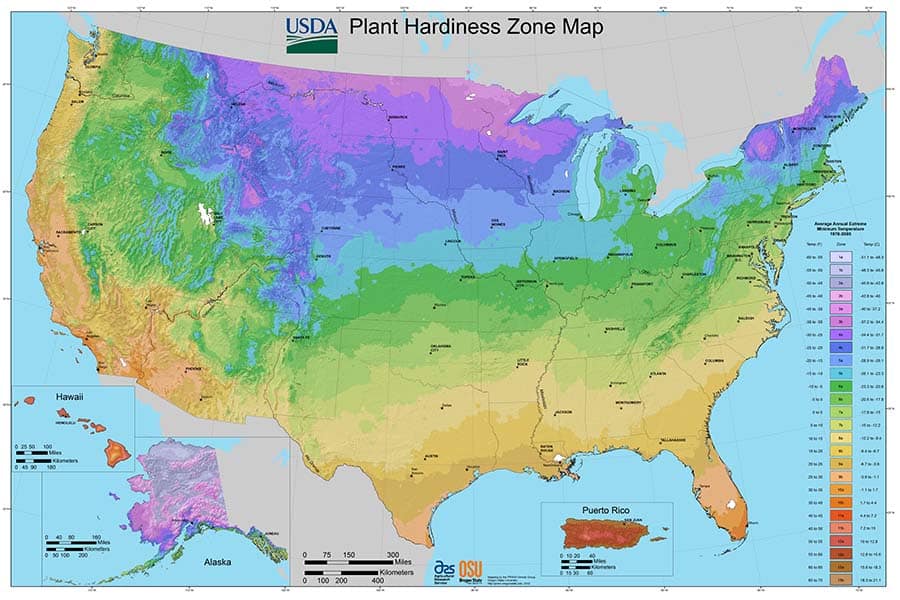
Many gardeners overlook this, drawn, instead, to a plant’s appearance or projected height and how it might fit with its surroundings.
But if your shrubs die because you live in a place too cold for them to thrive, planting them will have been a waste of time and resources.
Here are some great hedge plants and their average height. I’ve also included their best zones so you know which will be best for you:
| Plant Name | Avg. Height | Best Zones |
| Bearberry Cotoneaster, or Cotoneaster dammeri | 1’ (0.30 m) | 5-7 |
| Daisy Bush, or Olearia x scilloniensis | 6’ (1.82 m) | 8-10 |
| Dwarf Fothergilla, or Fothergilla gardenii | 3’ (0.91 m) | 5-9 |
| Bush Honeysuckle, or Diervilla lonicera | 3’ (0.91 m) | 3-10 |
| Edging Boxwood, or Buxus sempervirens “Suffruticosa” | 4’ (1.21 m) | 5-9 |
| English Yew, or Taxus baccata | 15’ (4.57 m) | 4-9 |
| Japanese Spindle: Euonymus fortunei “Gold Splash” | 2’ (0.60 m) | 5-8 |
| Japanese Spindle: Euonymus japonicus “Microphyllus Aureovariegatus” | 3’ (0.91 m) | 6-9 |
| Littleleaf Boxwood, or Buxus microphylla | 4’ (1.21 m) | 6-9 |
Euonymus Shrubs
There are almost 200 different plants that fall under the Euonymus umbrella.
Some grow no taller than about six inches (15.24 cm), while others can dwarf a tall adult.
When looking for a small hedge, you probably don’t want to go higher than about 48 inches (121.92 cm), though your available space will determine how tall your hedge can be.
Buxus, or Boxwood
Boxwood hedges are hugely popular because they stand up well to regular cutting, so if you’re looking for something you can trim every Saturday to make sure your hedge always looks clean, boxwoods are a fine option.
This shrub is especially popular for those who like to define outdoor spaces as “rooms,” or create geometric shapes out of the hedges.
Maintaining Your Hedges
Though shrubs are beautiful, and many are virtually maintenance-free, some do need an occasional trim. Because the right tool for the job is so important, before you go hacking away at your shrubbery, make sure you have what you need.
Two must-haves in your garden shed are hedge clippers and garden shears.
- Dewalt’s DCHT820B Hedge Trimmer (link to Amazon)
These Dewalt hedge trimmers are a great choice because of their 22 inch (55.88 cm) blade and cordless portability. Available on Amazon, their lightweight design makes it easy to trim even the tallest of hedges.
Amazon has several options for powered clippers that make quick work of most hedge trimming jobs. You can choose from gas-powered or electric (with or with a cord), but make sure you have a good, long blade on it.
2. Colwelt Hedge Clippers (link to Amazon)
For hedge clippers, I like the 21-inch (53.34 cm) Colwelt Hedge Clippers on Amazon. These are well-constructed with ergonomic handles, well-suited for large areas of hedges.
Amazon has plenty of clippers available, but remember, whichever you choose, be sure the blades are sharp because cleaner cuts are much better for the health of your plants. Besides that, a ragged cut will never look as nice as a clean one.
Trimming vs. Pruning
In addition to maintaining your hedges for looks, you’ll also need to prune them if you want to keep them healthy.
And while knowing the exact terms is not crucial to the plant’s survival, there is a difference between trimming and pruning that is worth noting.
Pruning
When you prune something, you’re removing unwanted growth to guide or train the plant to grow in a specific direction or manner.
If you want to manage the shape of a tree, you prune it accordingly, and it is advisable to learn which time of year it is best to prune your specific plant.
Trimming
Trimming, however, is done to maintain the health and appearance of plants.
If your hedges have some errant shoots sticking out above the plane of the top of them, trimming removes those, so the whole thing looks better, but it also forces the shrub to redirect resources it had been sending to that unwanted growth back into more established areas of the plant.
Therefore, trimming can be done throughout the year.
Most landscape owners with hedges will trim more than they prune. If you have a very structured, regimented garden, you likely won’t be too thrilled with some leaves sticking out of the side of your otherwise pristine wall of hedge, so you’ll be doing a lot of trimming.
Just remember that pruning is also necessary from time to time.
Shaping Your Hedges
Since many hedges have a boxy look, one might assume you just cut the front of them in a line perpendicular to the ground.
However, if you do that, you’ll end up with leaves and branches at the bottom of your hedge that don’t get the sun they need.
Angle Your Hedges for Better Growth
Instead, your hedge should be a little smaller toward the top.
So instead of a perpendicular line, you’ll make a slightly angled plane, angling in toward the center of the hedge to ensure the best access to sunlight for the whole plant.
Take Your Time
Also, cut slowly. Taking your time means cutting a small amount, stepping back for a look, then coming in to trim a little more.
It’s like getting a haircut. If your hairdresser cuts too much, there’s no way to fix that other than wait for it to grow back. The same is true with hedges.
Growing hedges and keeping them pretty takes time and patience, so, if you don’t have time to do it right, hedges may not be for you, especially if you want clean lines.
Related Articles:
- Can Hedge Trimmers Cut Branches?
- In-depth Guide: How To Fix A Jammed Hedge Trimmer?
- Can You Use an Electric Hedge Trimmer After the Rain?
When To Trim Your Hedges
Your hedges will go dormant in the fall and winter, but the best time to prune them is before your first frost.
However, you’re going to need to trim hedges during the summer since they’ll be growing then and making all your lines uneven.
Don’t Trim Your Hedges in Direct Sunlight
Another important thing to remember is whether you are trimming or pruning, do your best to avoid doing it any time of the year under full sun.
A cloudy day will lessen the chances of your leaves getting a bit of a sunburn.
Trim Your Hedges If Your Notice Damage
Of course, if there’s been something like storm damage to your hedges or the neighbor kid ran through them trying to catch a fly ball—you’ll want to trim immediately to get rid of damaged limbs that will eventually die.
You may also need to alter the shape of what you have to mitigate the damage, but that’s a special situation. In general, wait until the fall.
Sources
- Australian Cultivar Registration Authority: What is a Cultivar?
- Better Homes & Gardens: 19 Best Hedge Plants
- Better Homes & Gardens: Landscaping How-To: Plant a Hedge
- Country Living: 20 Best Boxwood Shrubs to Plant – Boxwood Bush and Hedge Ideas
- Gardening Know-How: Choosing Euonymus Shrubs: What Are Some Popular Euonymus Plant Varieties
- Gardner’s Path: The Best Shrubs for Creating Hedges
- Houzz: 9 Low-Growing Hedges That Make Good Neighbors
- Invasive Plant Atlas: Winter creeper: Euonymus fortunei (Celastrales: Celastraceae)
- Hortnews Iowa State University: Small, Deciduous Shrubs for the Landscape
- Leafy Place: 40 Small or Dwarf Evergreen Shrubs (With Pictures and Names)
- Missouri Botanical Garden: Buxus sempervirens – Plant Finder
- Morton Arboretum: Japanese spirea
- North Carolina State University: Euonymus japonicus (Box-Leaf Euonymus, Dwarf Japanese Euonymus (var. ‘Microphyllus’), Evergreen Euonymus, Japanese Euonymus, Japanese Spindle Tree, Spindle Tree)
- Oklahoma State University: Selecting Shrubs for the Landscape
- Oregon State University: Buxus sempervirens ‘Suffruticosa’
- Oregon State University: Euonymus japonicus
- This Old House: 15 Low-Maintenance Shrubs
- University of Arkansas: Arkansas Ornamental Shrubs
- University of Arkansas: Landscape Shrubs Littleleaf Boxwood (Buxus microphylla)
- University of Arkansas: Shrubs
- Wikipedia: Taxonomy mnemonic

